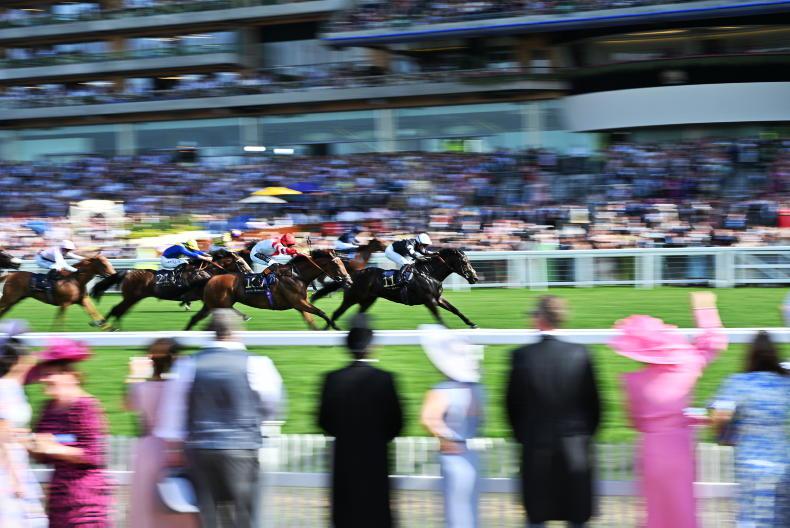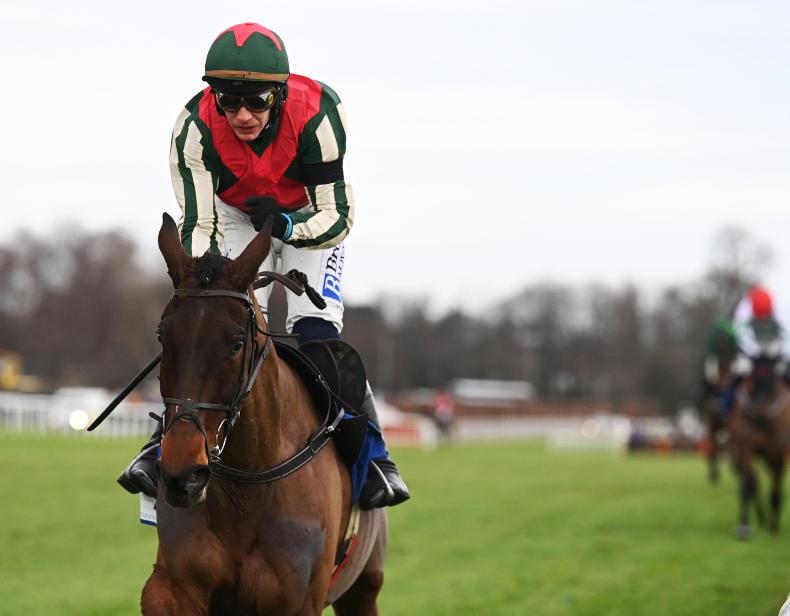THE numbers don’t lie. Since the launch of the Dublin Racing Festival in 2018, 45 of the 50 non-handicap races at the meeting have been farmed exclusively by Willie Mullins, Gordon Elliott, Henry de Bromhead and Joseph O’Brien.
It’s a statistic that tells you something special is required to upset Ireland’s powerhouse stables at the flagship meeting, but Tom Mullins believes he may have found just that in the highly-exciting youngster Fascile Mode. The Doninga, Co Kilkenny trainer knows a thing or two about discovering elite talent.
Despite Mullins’ older brother and 16-time champion trainer Willie racking up a total of 33 winners in bumpers so far this season, the best bumper horse in the country might well be housed just 10 minutes down the road from Closutton. Fascile Mode is already as short as 13/8 favourite for next Saturday’s Grade 2 Future Stars Bumper at the Dublin Racing Festival, having delivered a dazzling display to win a Leopardstown Christmas Festival bumper on his debut under the trainer’s son and amateur rider Charlie.
For the youngest of the Mullins clan, whose string of 35 horses is split 50-50 between flat and National Hunt nowadays, the chance to return to the big time is not lost on him.
This spring marks a decade since his second and most recent Cheltenham Festival success with Alderwood in the Grand Annual Chase. Selling his best young stock after wins in the early stages of their career has tended to make up the base of Mullins’ training model.
“Trainers like myself generally aren’t able to buy those nice young horses at the sales because they’ve become so expensive, so it was great that I was able to breed a mare I trained [named C’Est La Mode] to Walk In The Park and end up with Fascile Mode,” says Mullins.
“The very minute you see a nice young horse at the National Hunt store sales, it’s tough to compete because there are so many people interested with a view to going point-to-pointing. It seems like even if a horse has pulled up in a point-to-point at some stage they can get upwards of six figures. Best of luck to them.
“It’s the oldest saying in the book but if you can’t compete at the sales you won’t compete at the track, and trainers at my sort of level aren’t able to do that.”
Proven ability
Mullins has proven he is well capable of delivering at the top table when dealing with the right stock.
The trainer, who next year marks 20 years with a licence, started his career by plundering four Grade 1s with talented mare Asian Maze across 2005 and 2006, pulled off a top-level victory in the 2009 Hatton’s Grace Hurdle with Oscar Dan Dan and saddled Bob Lingo to win the 2012 Galway Plate for J.P. McManus.
The latter success came in the same year as Alderwood followed up a County Hurdle win at the Cheltenham Festival by striking in both the Grade 2 Rathbarry & Glenview Studs Novice Hurdle at Fairyhouse and Grade 1 Evening Herald Champion Novice Hurdle at Punchestown.
However - rightly or wrongly - Mullins has confined himself to the belief that an operation of his scale is unlikely to ever attract the type of big-spending owners who those at the top of National Hunt racing have on their side. He insists the sport would be much healthier, though, if influential backers looked beyond the leading handful of outfits when investing in horses.
Asked what he believes is the biggest challenge facing trainers in 2023, Mullins replies: “To stay going. To keep the whole thing alive. You’re literally getting it off the owner to pay the staff, cover the feed, hay, straw and diesel. I’d imagine most trainers are making nothing but they’re staying at it. It’s gone the way of the big lads winning the big races, and the multi-millionaires don’t seem to be coming down the line past the top two or three trainers.
“I have plenty of confidence in my ability to train. I’ll never get the horses but that’s the way it is. I have no doubt that if I had the horses I’d be as good as anyone. I don’t tend to pander to big owners and maybe that’s a part of it.”
Closutton dominance
Some argue that his brother being responsible for nearly half of the 28 ante-post favourites at this year’s Cheltenham Festival is not helpful for the sport’s wellbeing.
“I’d be biassed in wanting Willie to succeed but you’d often come away from the races some days after he’s had loads of winners and wonder whether the sport can handle that,” he says.
“While it mightn’t be great, the sport does keep bouncing back. Racing is so resilient and no matter what happens, or who wins all the races, it’s still going to be there. You’d wonder where we’d be, though, if Gordon [Elliott] wasn’t there to put it up to him. What would go on then?
“Nobody has done anything wrong by bringing the sport to a new level. Willie, Gordon and Henry [de Bromhead] are showing that if you want to be at the top, these are the horses you need. You need big owners. There’s no way of addressing it other than smaller trainers getting two or three top owners to take on the bigger yards.
“I thought it was a bit of a shock, and pretty significant, recently that there was a 35% drop in the initial entries for the Cheltenham Festival compared to the same stage five years ago. Nicky Henderson said he thinks Cheltenham is no longer the be-all and end-all for owners and trainers, but to me those statistics said that Willie and Gordon are mopping up races over there and trainers have decided to look elsewhere.”
Even if buying and winning with National Hunt horses has become more difficult in the era of the supertrainer, Mullins’ operation on the flat has continued to thrive in recent years.
When it comes to value purchases with relatively modest sums, his record makes for impressive reading.
Bargain buys
Since 2015, he has managed to win 13 maidens on the flat. None of his winners had gone through the ring as yearlings for more than €30,000. Two won on their debuts at Leopardstown, while the majority managed to collect within their first three starts at two or three.
Peace Mission cost just €900, Red Linn was bought back for €1,000, Powersville was picked up for €2,500 and dual-purpose performer Top Othe Ra, who notched seven wins and earned over €135,000 in prize money, fetched just €2,000 as a store. Group 3 Killavullan Stakes winner Stela Star, out of an unraced half-sister to Group 1 winner One Master, was picked up for €23,000 as a yearling and was later sold to continue her career in America.
Many of Mullins’ best performers over jumps were also purchased astutely. Alderwood cost €19,000 at the Goffs Land Rover Sale, Oscar Dan Dan joined Mullins for €20,000 at the Tattersalls Derby Sale, Bob Lingo was snapped up for €27,000 as a four-year-old, while Land Rover Bumper and valuable handicap hurdle winner Some Article cost €11,500 as a three-year-old.
Son and former Grand National-winning jockey David, who called time on a fruitful riding career in January 2021, also spotted the stable’s Grade B Porterstown Handicap Chase winner Court Maid for a mere €1,800 and Leinster National Handicap Chase winner Scoir Mear at €2,500.
What is it that the Mullins’ see in the sales ring that others apparently don’t?
“It’s the individual horse - if they look like a winner they probably will be one,” he insists.
“Getting the best sire you can is such an important element. If there’s a bit of blacktype in the second or third dam, combined with a nice sire, I’d love that. Flat pedigrees can go cold pretty quick but I do believe pedigrees come back, while if a pedigree gets into a bad line of sires I don’t think it’s going anywhere.
“There’s a lot more value in the flat, and there’s also a worldwide market. Nice yearlings can still go cheaply on the flat but it doesn’t really happen anymore when it comes to young National Hunt horses. Almost regardless of what a nice jumps horse is by, he’s going to make a lot of money.
“The jumps would have always been the core of our background here, and I’ll take horses under either code, but I’m enjoying the flat route. You have to be able to train them as well, I suppose! Experience is everything.”
Family ties
The influence of his late father Paddy is still a constant presence at Doninga. This year’s La Touche Cup at Punchestown will mark 70 years since the legendary trainer’s first winner, Flash Parade.
“Every week I always go back and remember what my father did with certain horses because he always took his time,” says Mullins.
“Some people got fed up with horses but he just pottered away and waited for the horses to come right. I took a lot from him in that sense. Every week I’m thinking ‘that’s something Dad did’, and it has proved profitable.
“Some horses are being rushed now to be ready at the age of four or to be early five-year-olds. Those lads need their horses to be winning or placed in point-to-points because there are big bills in the sales companies and they must produce the goods.
“You won’t sell a late five-year-old for the same money, and the younger the horse you can produce in a point-to-point, the more money you get. They’re being rushed but that’s the game. Fair play to them.”
Mullins is more than familiar with the territory of producing young horses to show potential before changing hands. High-class chaser Charbel was a talented graduate from his Kilkenny base, having won two bumpers for Mullins before joining Kim Bailey, but 2010 Supreme Novices’ Hurdle winner Menorah is the operation’s best known export.
Sold privately to Diana Whateley and Philip Hobbs after hosing up by 10 lengths on his debut in a Naas bumper for owner Eugene McDermott, the dual Grade 1 winner retired in 2017 as a 15-time winner who held an official rating of 169 in three separate years.
Mullins’ mind raced back to Menorah after watching an impressive piece of work from Fascile Mode in the lead-up to his Christmas success.
“That final bit of work he did before Leopardstown was exceptional,” says Mullins.
“The last horse I can remember working as well as him was Menorah. I quietly said to a few people going to Leopardstown that Fascile Mode’s work had reminded me of him, so it was nice to see him deliver.
“I’m very happy with how he’s been since Christmas. I was anxious to run him then in order to have those five or so weeks before the Dublin Racing Festival. I’m looking forward to running him again. Seeing a horse work as well as he did, and then to back it up on the track, is what it’s all about.”
Despite the challenges of competing in one of the most difficult eras of National Hunt racing in terms of the best horses being concentrated in a small number of hands, Mullins does not hesitate in his response when asked if training still gives him the same thrill as ever.
“I love it,” he says. “Especially to come across Fascile Mode, a winner on a big day… That gave me as good a kick as anything. But I probably haven’t had a horse like him since Alderwood. This horse might bring me to a Grade 1 again. Let’s hope so.”
‘The professional ranks have looked deeper in years gone by’
Retired Grand National-winning jockey Timmy Murphy expressed his belief earlier this week that the current crop of jump jockeys are a notch below the generations of riders he competed against during his time in the saddle, and Mullins has echoed similar sentiments.
When asked what he made of the standard of jockeys currently riding, Mullins says: “Not great. You have Rachael Blackmore, Paul Townend, Danny [Mullins] and Jack Kennedy as really brilliant riders at the very top, but the wider professional ranks have looked deeper in years gone by. It’s probably not overly strong at the moment but maybe it will come around again,
“One thing I’ve noticed with younger conditionals is that they’re in three or four different yards, whereas if they stuck to one they might be better off when it comes to getting rides. In my opinion, if they picked a yard and showed loyalty to that trainer by turning up every day they could make the trainer show some loyalty back in return with opportunities. If they’re hopping from yard to yard that’s far less likely to happen.”
On his son David’s decision to call time on his riding career at the age of 24, Mullins adds: “I was sad to see him go out but I understood where he was coming from.”


 This is a subscriber-only article
This is a subscriber-only article
 It looks like you're browsing in private mode
It looks like you're browsing in private mode














SHARING OPTIONS: